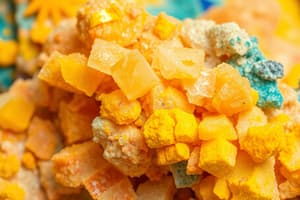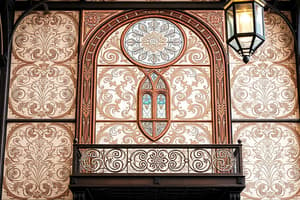Podcast
Questions and Answers
What is the maximum temperature that can be reached behind the calcining plane during the gypsum wallboard process?
What is the maximum temperature that can be reached behind the calcining plane during the gypsum wallboard process?
- 180°F
- 250°F
- 150°F
- 212°F (correct)
What provides 2-hour fire protection for structural beams according to the content?
What provides 2-hour fire protection for structural beams according to the content?
- Two layers of Type X wallboard (correct)
- One layer of concrete around the beam
- A single layer of Type X wallboard
- Two layers of regular wallboard
How are metal studs typically arranged around I-beams for wallboard application?
How are metal studs typically arranged around I-beams for wallboard application?
- At 30-inch centers, extending only above the beam
- At 12-inch centers, extending 6 inches above the beam
- At 24-inch centers, extending 12 inches below the beam (correct)
- At 24-inch centers, flush with the beam
What happens to the material after the calcining process is complete?
What happens to the material after the calcining process is complete?
What is the primary purpose of using gypsum wallboard on steel columns?
What is the primary purpose of using gypsum wallboard on steel columns?
Flashcards
How does gypsum wallboard protect steel beams during a fire?
How does gypsum wallboard protect steel beams during a fire?
Gypsum wallboard acts as a fire barrier by releasing water when heated, creating a protective layer against heat transfer. The process slows down the calcining process, ensuring temperatures do not exceed the boiling point of water (212°F).
What are metal studs for in steel beam fire protection?
What are metal studs for in steel beam fire protection?
Metal studs are used to create a framework around steel I-beams, allowing for the attachment of gypsum wallboard layers to provide fire protection. These studs are placed on 24-inch centers, with a 12-inch gap below the beam for potential expansion or contraction.
How long does a double layer of Type X wallboard protect a steel beam for?
How long does a double layer of Type X wallboard protect a steel beam for?
Type X wallboard, in two layers, offers 2-hour fire protection for steel beams. The layers are staggered and fastened together using screws or laminated layers, reducing the need for excessive fasteners.
What are bottom rips?
What are bottom rips?
Signup and view all the flashcards
What is the calcining process?
What is the calcining process?
Signup and view all the flashcards
Study Notes
Steel Beam and Column Protection
- Steel columns or other structural members are protected from fire using gypsum wallboard.
- Fire resistance ratings range from 2 to 4 hours.
- Gypsum wallboard, when exposed to heat, undergoes a process of calcination.
- This process combines water in the gypsum chemically.
- The result is a material that retards heat transfer, acts as insulation, and is non-combustible.
- A white, chalky material remains after calcination.
- This process maintains the temperature below the boiling point of water (212°F).
Metal Stud Furring
- Metal stud furring is sometimes used to cover large I-beams with gypsum wallboard, providing fire protection.
- This is covered by gypsum wallboard, then fastened to ceiling runners that are attached to a concrete slab using tools and fasteners.
- Sections of studs run downward from the ceiling runners to a bottom runner.
- Studs are spaced 24 inches apart.
- This assembly should extend at least 12 inches below the beam.
- This allows for future expansion or contraction of the beam.
- Staggered joints and screws or lamination are used to minimize the number of fasteners.
- Using Type X wallboard in two layers provides 2-hour fire protection for the beam.
Studying That Suits You
Use AI to generate personalized quizzes and flashcards to suit your learning preferences.




